Index to Trees & Shrubs in the Order Malpighiales
Family: Euphorbiaceae (Euphorbia Family)
345. Euphorbia confinalis Lembobo Euphorbia viewtopic.php?f=248&t=3753&p=170792#p171738
346. Euphorbia cooperi Bushveld Candelabra Euphorbia viewtopic.php?f=248&t=3753&p=179976#p179976
351. Euphorbia ingens Common Tree Euphorbia, Candelabra Tree viewtopic.php?f=248&p=171744#p171744
341. Spirostachys africana Tamboti viewtopic.php?p=230606#p230606
Family: Ochnaceae (Wild Plane Family)
480.1. Ochna inermis Stunted Plane viewtopic.php?p=251628#p251628
481. Ochna natalitia Natal Plane, Coast Boxwood viewtopic.php?p=224237#p224237
Family: Phyllanthaceae
309. Flueggea virosa White Berry-bush viewtopic.php?p=526945#p526945
Family: Rhizophoraceae (Onionwoods)
527. Bruguiera gymnorrhizaBlack Mangrove viewtopic.php?p=276647#p276647
Family: Salicaceae (Willow and Poplar Family)
507. Dovyalis caffra Kei-apple Sourberry, Dingaan's Apple, Dingaan's Apricot viewtopic.php?f=248&t=3753&p=171747#p171747
492. Oncoba spinosa Snuff-box Tree, Fried Egg Tree viewtopic.php?f=248&t=3753&p=171749#p171749
Africa Wild Tree & Shrub Book - Order Malpighiales
Moderator: Klipspringer
Re: Africa Wild Tree & Shrub Book - Order Malpighiales
345. Lembobo Euphorbia Euphorbia confinalis confinalis (Lebombo-naboom)
Order: Malpighiales. Family: Euphorbiaceae
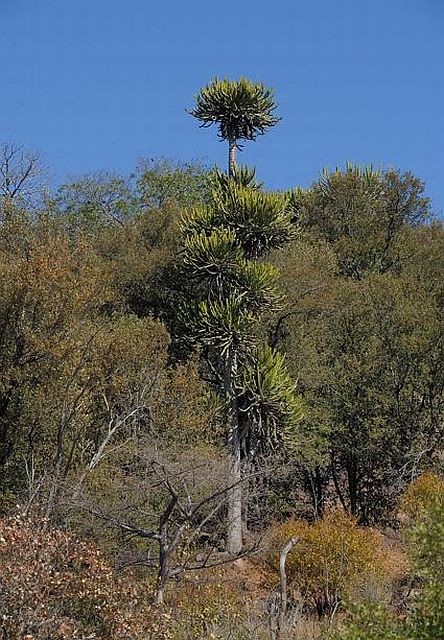
Mahonie Loop near Punda Maria in Kruger National Park
Description
3-10 m. Succulent spiny slender single-stemmed tree with a crown of curved, ascending branches. Main stem tall, often branched, each large branch with crown of four-winged branchlets 70 mm diam. Spines 5 mm. Stem and branches 3-4-angled, constricted at the nodes; segments with parallel sides. Spine-shields stout and conspicuous.
Distribution
Not endemic to South Africa. Found in Zimbabwe, Mozambique and South Africa (Limpopo, Mpumalanga)
Habitat
Rocky hills in deciduous woodland, riverine vegetation and savanna
Links: Braam Van Wyk, Piet Van Wyk: Field Guide to Trees of Southern Africa
Order: Malpighiales. Family: Euphorbiaceae

Mahonie Loop near Punda Maria in Kruger National Park
Description
3-10 m. Succulent spiny slender single-stemmed tree with a crown of curved, ascending branches. Main stem tall, often branched, each large branch with crown of four-winged branchlets 70 mm diam. Spines 5 mm. Stem and branches 3-4-angled, constricted at the nodes; segments with parallel sides. Spine-shields stout and conspicuous.
Distribution
Not endemic to South Africa. Found in Zimbabwe, Mozambique and South Africa (Limpopo, Mpumalanga)
Habitat
Rocky hills in deciduous woodland, riverine vegetation and savanna
Links: Braam Van Wyk, Piet Van Wyk: Field Guide to Trees of Southern Africa
Dewi
What is the good of having a nice house without a decent planet to put it on? (H D Thoreau)
What is the good of having a nice house without a decent planet to put it on? (H D Thoreau)
Re: Africa Wild Tree & Shrub Book - Order Malpighiales
351. Common Tree Euphorbia, Candelabra Tree Euphorbia ingens (Naboom)
Order: Malpighiales. Family: Euphorbiaceae

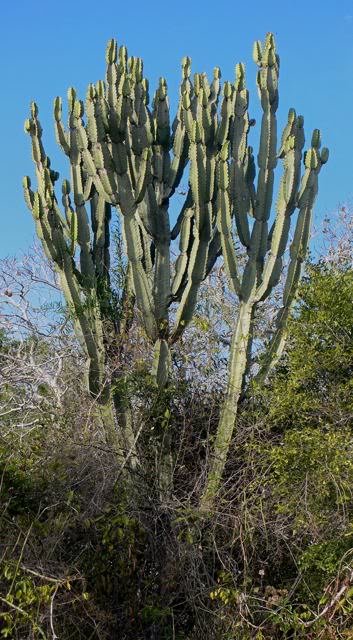
Description
An upright, succulent tree with a dark green crown which is well rounded and often shaped like a hot-air balloon. Grows up to 12 m. Main stem short, angled. Massive single crown. Bark textured, grey. Side branches with four wing-like angles. The branches are segmented with spines running along the ridges of the segments. Spines paired, 2 mm, do not form continuous ridge. It produces small, greenish yellow flowers on the ridges of the topmost segment of every branch from autumn to winter (April-May). The fruit, a round 3-lobed capsule, turns red to purple when ripening.
As with many species of Euphorbia, the milky latex is poisonous and highly irritant to skin. When coming into contact with the eyes, it may cause temporary blindness.
Distribution
Distributed throughout KwaZulu-Natal, Swaziland, Limpopo Province, Gauteng, North-West Province, Mozambique, Zimbabwe and further into tropical Africa.
Habitat
A common plant of the Northeast which prefers dry, rocky areas or deep sand within bushveld vegetation. Often grows from termite mounds.
This tree can survive in areas that go through long periods of drought or are generally very dry.
Links: Wild About Trees; PlantZAfrica
Order: Malpighiales. Family: Euphorbiaceae


Description
An upright, succulent tree with a dark green crown which is well rounded and often shaped like a hot-air balloon. Grows up to 12 m. Main stem short, angled. Massive single crown. Bark textured, grey. Side branches with four wing-like angles. The branches are segmented with spines running along the ridges of the segments. Spines paired, 2 mm, do not form continuous ridge. It produces small, greenish yellow flowers on the ridges of the topmost segment of every branch from autumn to winter (April-May). The fruit, a round 3-lobed capsule, turns red to purple when ripening.
As with many species of Euphorbia, the milky latex is poisonous and highly irritant to skin. When coming into contact with the eyes, it may cause temporary blindness.
Distribution
Distributed throughout KwaZulu-Natal, Swaziland, Limpopo Province, Gauteng, North-West Province, Mozambique, Zimbabwe and further into tropical Africa.
Habitat
A common plant of the Northeast which prefers dry, rocky areas or deep sand within bushveld vegetation. Often grows from termite mounds.
This tree can survive in areas that go through long periods of drought or are generally very dry.
Links: Wild About Trees; PlantZAfrica
Dewi
What is the good of having a nice house without a decent planet to put it on? (H D Thoreau)
What is the good of having a nice house without a decent planet to put it on? (H D Thoreau)
Re: Africa Wild Tree & Shrub Book - Order Malpighiales
507. Kei-apple Sourberry, Dingaan's Apple, Dingaan's Apricot Dovyalis caffra (Kei-appel, Appelkoosdoring)
Order: Malpighiales. Family: Salicaceae
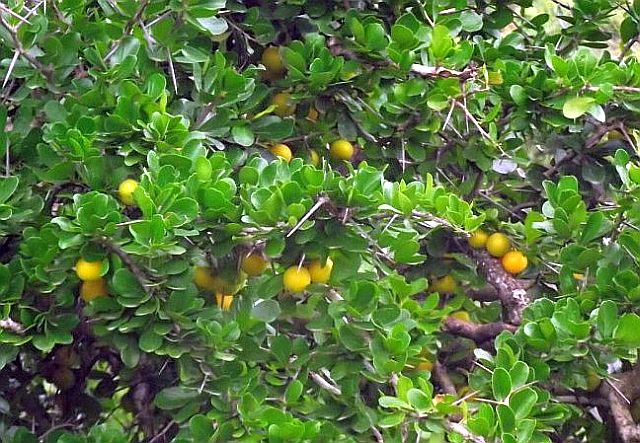 © mposthumus
© mposthumus
Kruger National Park
Description
Dovyalis caffra is usually 3-5 m in height, but sometimes reaches 8 m with a much branched crown. It is a tree or spiny shrub of moderate growth rate that may be planted close together to form a good hedge. Leaves are simple and occur in clusters on dwarf side branches but alternate on
young shoots, dark green with a waxy luster, with 3 to 5 prominent veins from base on both sides. The leaf tip is rounded to notched, leaf margin is smooth, slightly rolled under and base tapering to a leafstalk up to 5 mm long. Long, straight, stout, singly born spines, up to 60 mm long, are common on younger plants, although when older, branches may be spineless. Creamy green flowers form in November to December. Male flowers are 3 mm long in dense clusters of 5-10 flowers. Female flowers are found in groups of up to three on stalks 4-10 mm long in leaf axils.
The fruits are yellowish orange in colour, roundish, fleshy and thin-skinned. When ripe, the fruit contains up to 12 woolly seeds (Dec – Apr) (30 – 60 mm diam.).
Distribution
From Eastern Cape through KwaZulu-Natal to Swaziland, into Limpopo and Zimbabwe.
Habitat
It grows in valley bushveld, dry areas, wooded grassland, on forest edges.
Links: Wild About Trees; Braam Van Wyk, Piet Van Wyk: How to Identify Trees in Southern Africa
Order: Malpighiales. Family: Salicaceae
 © mposthumus
© mposthumusKruger National Park
Description
Dovyalis caffra is usually 3-5 m in height, but sometimes reaches 8 m with a much branched crown. It is a tree or spiny shrub of moderate growth rate that may be planted close together to form a good hedge. Leaves are simple and occur in clusters on dwarf side branches but alternate on
young shoots, dark green with a waxy luster, with 3 to 5 prominent veins from base on both sides. The leaf tip is rounded to notched, leaf margin is smooth, slightly rolled under and base tapering to a leafstalk up to 5 mm long. Long, straight, stout, singly born spines, up to 60 mm long, are common on younger plants, although when older, branches may be spineless. Creamy green flowers form in November to December. Male flowers are 3 mm long in dense clusters of 5-10 flowers. Female flowers are found in groups of up to three on stalks 4-10 mm long in leaf axils.
The fruits are yellowish orange in colour, roundish, fleshy and thin-skinned. When ripe, the fruit contains up to 12 woolly seeds (Dec – Apr) (30 – 60 mm diam.).
Distribution
From Eastern Cape through KwaZulu-Natal to Swaziland, into Limpopo and Zimbabwe.
Habitat
It grows in valley bushveld, dry areas, wooded grassland, on forest edges.
Links: Wild About Trees; Braam Van Wyk, Piet Van Wyk: How to Identify Trees in Southern Africa
Re: Africa Wild Tree & Shrub Book - Order Malpighiales
492. Snuff-box Tree, Fried Egg Tree Oncoba spinosa (Snuifkalbassie)
Order: Malpighiales. Family: Salicaceae
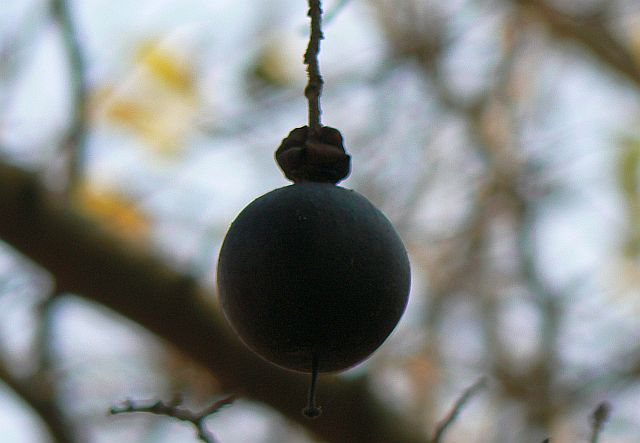
Kruger National Park, Lower Sabie
Description
Glabrous shrub or small tree. The snuff-box tree grows up to 5 m, but may sometimes reach a height of 8 m. The bark of this plant is mottled grey and rather smooth. The young branches are conspicuously speckled with lenticels (a slightly raised, lens-shaped area on the surface of the young stems that helps with the exchange of gasses between the plant and the surrounding air), armed with straight axillary spines up to 50 mm long. The leaves are simple, ovate-elliptic in form with a somewhat pointed tip and rounded, broad base. The leaves are dark, glossy green in colour and somewhat leathery and hairless. The margins are coarsely toothed.
It bears large (90 mm wide) showy, sweet-scented, white flowers with masses of yellow, overlapping stamens in the centre. Flowers somewhat resemble a fried egg and in Zimbabwe it is called the fried-egg flower. The flowers are bisexual and are borne at in the base of the leaves or at the end of the branches. It flowers from September to January. The ovary is one-chambered. The rounded fruit of up to 60 mm in diameter, consists of a hard shell that becomes dark-reddish brown when mature and small, with shiny brown seeds embedded in a dry, sour, yellowish pulp. Fruit can be found on the tree from April to July.
Distribution
This is a tropical species occurring from Arabia southwards through tropical Africa to S Africa as far south as Natal, but nowhere in South Africa is it really abundant. This tree occurs in the northeastern part of South Africa (KwaZulu-Natal, Limpopo, Mpumalanga) and further north along the Zambezi River.
Habitat
It is found over a large range of altitudes, from bushveld areas to riverine fringe forest.
Order: Malpighiales. Family: Salicaceae

Kruger National Park, Lower Sabie
Description
Glabrous shrub or small tree. The snuff-box tree grows up to 5 m, but may sometimes reach a height of 8 m. The bark of this plant is mottled grey and rather smooth. The young branches are conspicuously speckled with lenticels (a slightly raised, lens-shaped area on the surface of the young stems that helps with the exchange of gasses between the plant and the surrounding air), armed with straight axillary spines up to 50 mm long. The leaves are simple, ovate-elliptic in form with a somewhat pointed tip and rounded, broad base. The leaves are dark, glossy green in colour and somewhat leathery and hairless. The margins are coarsely toothed.
It bears large (90 mm wide) showy, sweet-scented, white flowers with masses of yellow, overlapping stamens in the centre. Flowers somewhat resemble a fried egg and in Zimbabwe it is called the fried-egg flower. The flowers are bisexual and are borne at in the base of the leaves or at the end of the branches. It flowers from September to January. The ovary is one-chambered. The rounded fruit of up to 60 mm in diameter, consists of a hard shell that becomes dark-reddish brown when mature and small, with shiny brown seeds embedded in a dry, sour, yellowish pulp. Fruit can be found on the tree from April to July.
Distribution
This is a tropical species occurring from Arabia southwards through tropical Africa to S Africa as far south as Natal, but nowhere in South Africa is it really abundant. This tree occurs in the northeastern part of South Africa (KwaZulu-Natal, Limpopo, Mpumalanga) and further north along the Zambezi River.
Habitat
It is found over a large range of altitudes, from bushveld areas to riverine fringe forest.
Re: Africa Wild Tree & Shrub Book - Order Malpighiales
346. Bushveld Candelabra Euphorbia, Deadliest Euphorbia Euphorbia cooperi
Order: Malpighiales. Family: Euphorbiaceae
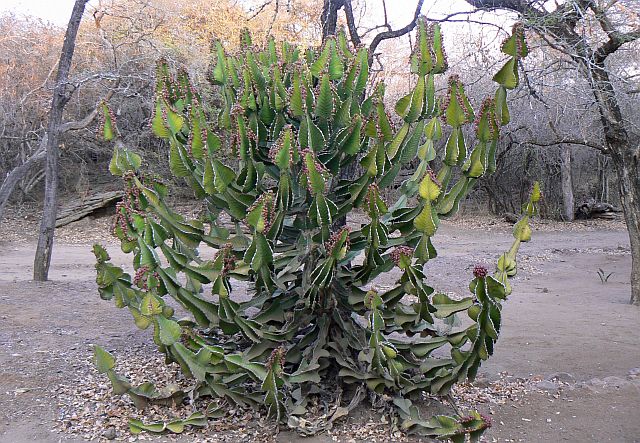 © Toko
© Toko
Hlane Royal National Park, Swaziland
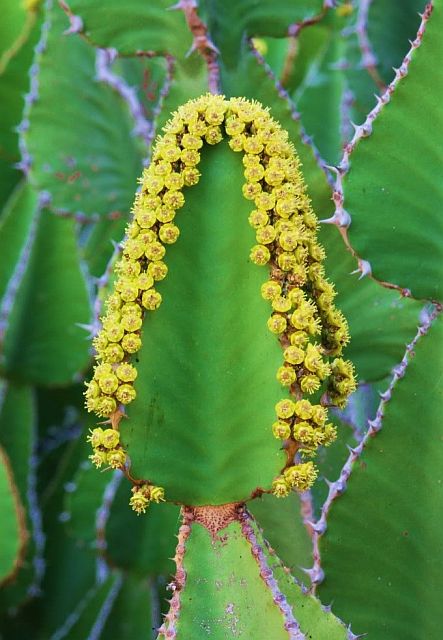 Flowers © General Gump
Flowers © General Gump
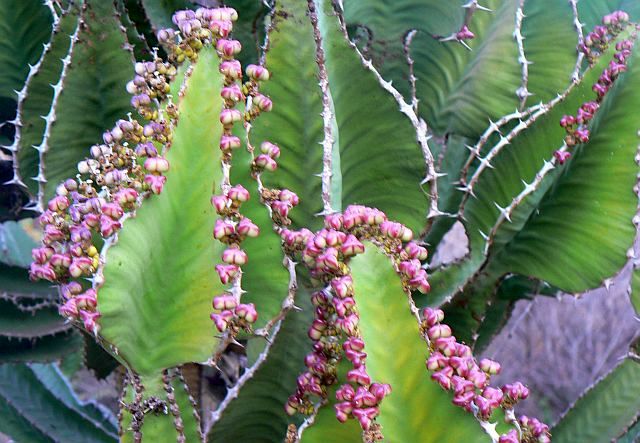 Fruits © Toko
Fruits © Toko
Kruger National Park Orpen dam lookout © Dzombo
Description
This succulent grows to a maximum of 7 m. It has spines along the edges of each ridge to it's branches and gives off a poisonous white latex when damaged. It has a naked, grey trunk, up to 3 m high. Round holes on the trunk indicate where old branches have fallen off. Branches (succulent leaves) are conspicuously 4- to 6-winged and resemble a chunky string of beads. The triangular segments are 50-150 x 120 mm. The spines form a spiky margin along each ridge on the branches. Spines are found in pairs and are usually 5 to 7 mm long.
The yellowish green, bisexual flowers, which are clustered along ridges between the spines, are found in groups of 3 cymes (flower formed at the tip and subsequent ones formed below) situated towards the tips of the branches. Flowers bloom in September and October which also coincides with fruit production.
The fruit is a 3-lobed capsule, 15 x 8 mm long and green in colour. Red markings are also visible on the fruit which appear in September to October onwards and overlap with the flowering time.
The Euphorbia's are also eaten by black rhino, whilst baboons will eat the fruit.
The branches can be broken off and thrown into pools of water to bring stupefied fish up to the surface.
Distribution
Eastern Botwsana, southern Mozambique, Zimbabwe, Swaziland and Limpopo, Mpumalanga, KwaZulu-Natal, South Africa.
Habitat
It is mostly found in wooded grassland and rocky places.
Order: Malpighiales. Family: Euphorbiaceae
 © Toko
© TokoHlane Royal National Park, Swaziland
 Flowers © General Gump
Flowers © General Gump Fruits © Toko
Fruits © TokoKruger National Park Orpen dam lookout © Dzombo
Description
This succulent grows to a maximum of 7 m. It has spines along the edges of each ridge to it's branches and gives off a poisonous white latex when damaged. It has a naked, grey trunk, up to 3 m high. Round holes on the trunk indicate where old branches have fallen off. Branches (succulent leaves) are conspicuously 4- to 6-winged and resemble a chunky string of beads. The triangular segments are 50-150 x 120 mm. The spines form a spiky margin along each ridge on the branches. Spines are found in pairs and are usually 5 to 7 mm long.
The yellowish green, bisexual flowers, which are clustered along ridges between the spines, are found in groups of 3 cymes (flower formed at the tip and subsequent ones formed below) situated towards the tips of the branches. Flowers bloom in September and October which also coincides with fruit production.
The fruit is a 3-lobed capsule, 15 x 8 mm long and green in colour. Red markings are also visible on the fruit which appear in September to October onwards and overlap with the flowering time.
The Euphorbia's are also eaten by black rhino, whilst baboons will eat the fruit.
The branches can be broken off and thrown into pools of water to bring stupefied fish up to the surface.
Distribution
Eastern Botwsana, southern Mozambique, Zimbabwe, Swaziland and Limpopo, Mpumalanga, KwaZulu-Natal, South Africa.
Habitat
It is mostly found in wooded grassland and rocky places.
Re: Africa Wild Tree & Shrub Book - Order Malpighiales
481. Natal Plane, Coast Boxwood Ochna natalitia (Natalrooihout)
Order: Malpighiales. Family: Ochnaceae
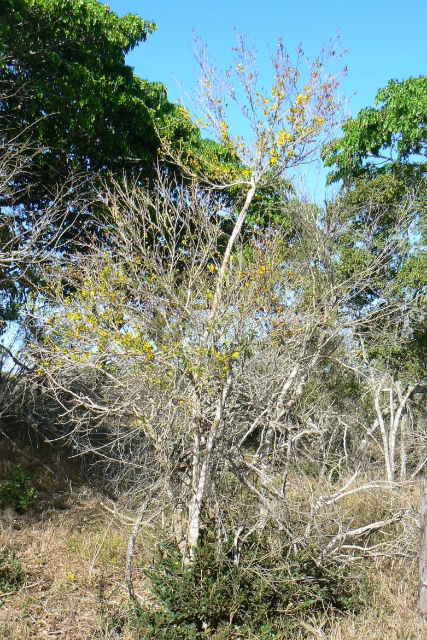 © Toko
© Toko
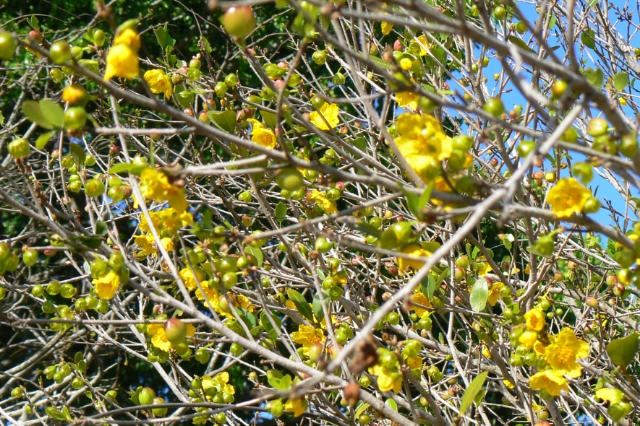 © Toko
© Toko
Tembe Elephant Park, KwaZulu-Natal
Description
A small, evergreen multi-stemmed tree or shrub, hairless throughout, to 4 m in height. Stems round with numerous pale lenticels. The bark is dark and rough. The leaves are alternate, simple and elliptic, 50–200 x 10–45 mm, and dark green with the new leaves red in spring. The flowers, borne in a cluster, are large and golden yellow. Inflorescences scented, sometimes elongated at end of lateral short shoots, sometimes of only a few flowers; stalk c 7 mm long; petals yellow, c 7 mm long x 4 mm wide. Flowering time: September –December. Fruits black, fleshy on bright red thickened base. Plants often have conspicuous red leafy insect-galls.
Distribution
Found in Limpopo, North-West, Gauteng, KwaZulu-Natal and Eastern Cape, and also in Swaziland, Zimbabwe and Mozambique.
Habitat
Found on rocky outcrops and in bushveld.
Links: Trees and Shrubs of Mpumalanga and Kruger National Park
Order: Malpighiales. Family: Ochnaceae
 © Toko
© Toko © Toko
© TokoTembe Elephant Park, KwaZulu-Natal
Description
A small, evergreen multi-stemmed tree or shrub, hairless throughout, to 4 m in height. Stems round with numerous pale lenticels. The bark is dark and rough. The leaves are alternate, simple and elliptic, 50–200 x 10–45 mm, and dark green with the new leaves red in spring. The flowers, borne in a cluster, are large and golden yellow. Inflorescences scented, sometimes elongated at end of lateral short shoots, sometimes of only a few flowers; stalk c 7 mm long; petals yellow, c 7 mm long x 4 mm wide. Flowering time: September –December. Fruits black, fleshy on bright red thickened base. Plants often have conspicuous red leafy insect-galls.
Distribution
Found in Limpopo, North-West, Gauteng, KwaZulu-Natal and Eastern Cape, and also in Swaziland, Zimbabwe and Mozambique.
Habitat
Found on rocky outcrops and in bushveld.
Links: Trees and Shrubs of Mpumalanga and Kruger National Park
Re: Africa Wild Tree & Shrub Book - Order Malpighiales
341. Tamboti Spirostachys africana (Tambotie)
Order: Malpighiales. Family: Euphorbiaceae
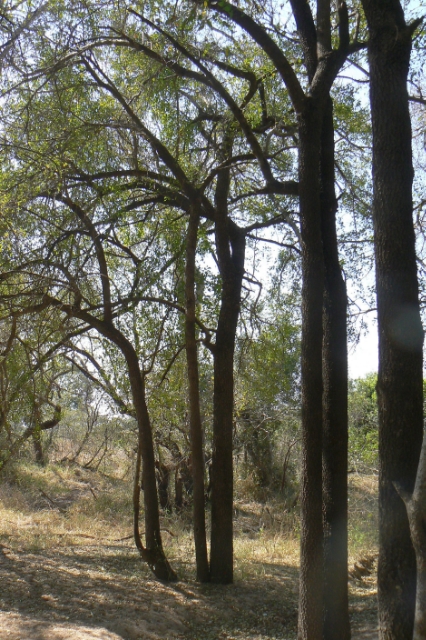
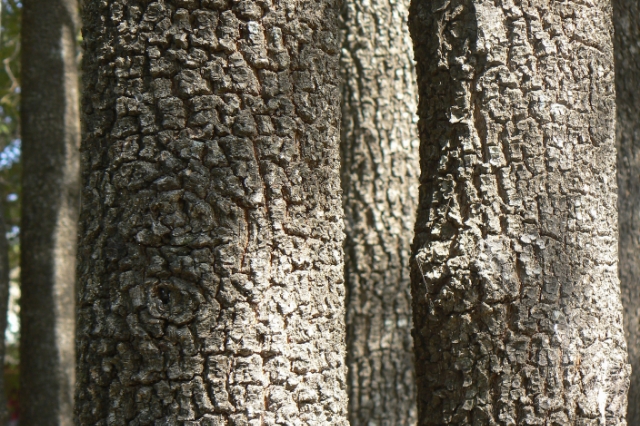
Kruger National Park, Afsaal
Description
Spirostachys africana grow as single, tall trees, or in larger groups of trees with thinner trunks, forming groves. It is a medium-sized deciduous straight tree, up to 13 m tall, with a rounded crown.
Bark dark grey to blackish, rough, cracking in rectangular pieces.
Leaves spirally arranged, alternate, elliptic to ovate, up to 7 cm long, dull green, hairless or slightly hairy; base with 2 small glands at the junction with the petiole; margins shallowly crenate. Stalk 1 cm long. Leaves show striking yellow and red autumn colours.
Flowers unisexual on the same plant, in catkin like spikes, deep red. Inflorescences short lateral spikes, sometimes sexes in separate spikes, sometimes few female flowers at base, others male. No petals. Calyx usually five-lobed. Male spikes densely many-flowered, up to 3 cm long, singly or in small axillary clusters, persisting on otherwise bare branches; stamens three, filaments joined. Female parts of the flower-spikes give the tree an overall red sheen late in winter and early spring, before the new leaves appear. Male flowers are yellow due to the abundance of pollen (July to November).
Fruit woody and 3-lobed, 6×13 mm, yellowish, dehiscent. The capsules ripen on hot summer days and split with an audible explosion.
All parts of the tree produce white, milky, irritant juice (latex) when broken or cut.
Distribution
Tanzania, Angola, Namibia, Botswana, Zimbabwe, Mozambique, Swaziland, South Africa (Gauteng, KwaZulu-Natal, Limpopo, Mpumalanga, North West).
Habitat
In deciduous woodland, often along rivers and streams. Tamboti trees most often grow in patches of uniform Tamboti forest, either close to a river, often on clay, or in a rocky area.
Links: PlantZAfrica; Trees and Shrubs of Mpumalanga and Kruger National Park
Order: Malpighiales. Family: Euphorbiaceae


Kruger National Park, Afsaal
Description
Spirostachys africana grow as single, tall trees, or in larger groups of trees with thinner trunks, forming groves. It is a medium-sized deciduous straight tree, up to 13 m tall, with a rounded crown.
Bark dark grey to blackish, rough, cracking in rectangular pieces.
Leaves spirally arranged, alternate, elliptic to ovate, up to 7 cm long, dull green, hairless or slightly hairy; base with 2 small glands at the junction with the petiole; margins shallowly crenate. Stalk 1 cm long. Leaves show striking yellow and red autumn colours.
Flowers unisexual on the same plant, in catkin like spikes, deep red. Inflorescences short lateral spikes, sometimes sexes in separate spikes, sometimes few female flowers at base, others male. No petals. Calyx usually five-lobed. Male spikes densely many-flowered, up to 3 cm long, singly or in small axillary clusters, persisting on otherwise bare branches; stamens three, filaments joined. Female parts of the flower-spikes give the tree an overall red sheen late in winter and early spring, before the new leaves appear. Male flowers are yellow due to the abundance of pollen (July to November).
Fruit woody and 3-lobed, 6×13 mm, yellowish, dehiscent. The capsules ripen on hot summer days and split with an audible explosion.
All parts of the tree produce white, milky, irritant juice (latex) when broken or cut.
Distribution
Tanzania, Angola, Namibia, Botswana, Zimbabwe, Mozambique, Swaziland, South Africa (Gauteng, KwaZulu-Natal, Limpopo, Mpumalanga, North West).
Habitat
In deciduous woodland, often along rivers and streams. Tamboti trees most often grow in patches of uniform Tamboti forest, either close to a river, often on clay, or in a rocky area.
Links: PlantZAfrica; Trees and Shrubs of Mpumalanga and Kruger National Park
Africa Wild Tree & Shrub Book - Order Malpighiales
480.1. Stunted Plane Ochna inermis
Order Malpighiales. Family Ochnaceae



Kruger National Parl, along the Mahonie Loop, Nov 2014 © arks
Description
Mostly a rounded shrub, rarely a small tree. Branches greyish to whitish, covered in white lenticels. Leaves broadly elliptic to almost round, up to c. 5 cm long; margin finely but sharply toothed.
Flowers axillary on short side branchlets, solitary or in pairs, golden yellow, c. 2 cm in diameter, short-lived. Flowering time: October to November.
Fruit 1-5 carpels, up to 10 × 7 mm, attached near the base, purple-black when ripe, surrounded by the pink to red, persistent sepals.
Distribution
Southern population in Botswana, Mozambique, Zimbabwe, northern South Africa (Limpopo, Mpumalanga, North West)
Habitat
In dry Acacia, Commiphora or Mopane scrub, among rocks or in sandy or rocky soils.
Links:
https://books.google.de/books?id=RpVJJH ... rk&f=false
Order Malpighiales. Family Ochnaceae



Kruger National Parl, along the Mahonie Loop, Nov 2014 © arks
Description
Mostly a rounded shrub, rarely a small tree. Branches greyish to whitish, covered in white lenticels. Leaves broadly elliptic to almost round, up to c. 5 cm long; margin finely but sharply toothed.
Flowers axillary on short side branchlets, solitary or in pairs, golden yellow, c. 2 cm in diameter, short-lived. Flowering time: October to November.
Fruit 1-5 carpels, up to 10 × 7 mm, attached near the base, purple-black when ripe, surrounded by the pink to red, persistent sepals.
Distribution
Southern population in Botswana, Mozambique, Zimbabwe, northern South Africa (Limpopo, Mpumalanga, North West)
Habitat
In dry Acacia, Commiphora or Mopane scrub, among rocks or in sandy or rocky soils.
Links:
https://books.google.de/books?id=RpVJJH ... rk&f=false
Re: Africa Wild Tree & Shrub Book - Order Malpighiales
527. Black Mangrove, Cigar-tree Bruguiera gymnorrhiza (Swartwortelboom)
Order: Malpighiales. Family: Rhizophoraceae
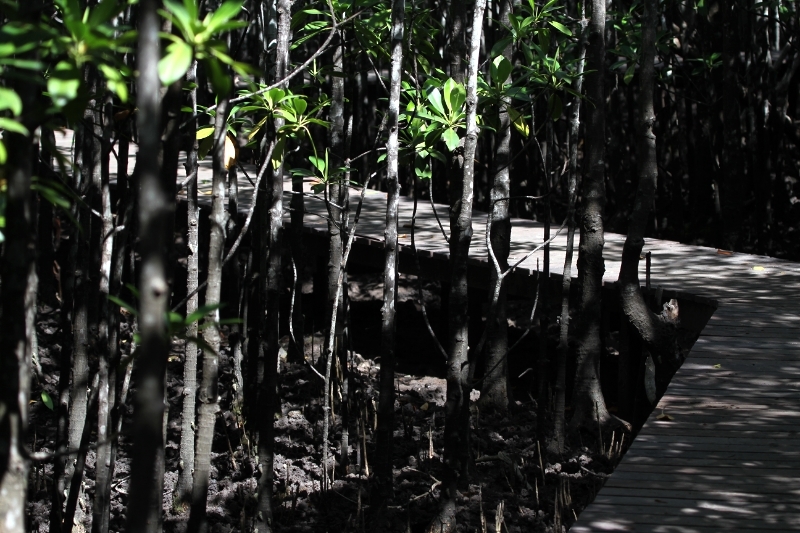 © Tina
© Tina
uMlalazi Nature Reserve
Description
Key ID: Small, dark-stemmed trees. Buttressed stem-base with distinctive knee-like, aerial roots. Cigar-shaped fruit hangs from rubbery flower petals.
Tree up to about 10 m tall, but often less; crown conical at first but later more irregular; bark black, rough; with knee-roots. New growth green becoming grey, glossy, hairless.
Leaves opposite, crowded at the ends of branches, roughly elliptical, 60-120 x 20-60 mm, hairless, glossy apple green when young, becoming yellow with age; margins plain, not toothed or scalloped, slightly rolled under, tip pointed but without a spine, base narrowed, stalk up to 30 mm long; with interpetiolar stipules that fall early. (Interpetiolar stipules are small, triangular, leaflike outgrowths on the stem between and so at right angles to the opposite leaf stalks; they are usually a trademark of the coffee family, Rubiaceae, and mangroves are one of the very few other groups of plants to have this feature.)
Flowers solitary, up to 40 mm long; petals and sepals 8-18, petals creamy white, falling with the stamens; sepals green in shade, pink in direct sun. Fruit a fleshy berry up to 25 mm long, germinating on the tree to form a ribbed, brown hypocotyl (incipient root) about 110 mm long. Trees grow slowly and are probably quite long-lived.
Distribution
Black mangrove is one of the most widely distributed trees in the tropics, and occurs along the east coast of Africa from just north of East London (Eastern Cape) to KwaZulu-Natal, Somalia, Madagascar and the Indian Ocean islands, the south Asian coast from Iran to China, north Australia and numerous tiny (and larger) islands in the Pacific.
Habitat
It grows on the seaward side of estuaries in mud, in places that are well watered and frost free.
Order: Malpighiales. Family: Rhizophoraceae
 © Tina
© TinauMlalazi Nature Reserve
Description
Key ID: Small, dark-stemmed trees. Buttressed stem-base with distinctive knee-like, aerial roots. Cigar-shaped fruit hangs from rubbery flower petals.
Tree up to about 10 m tall, but often less; crown conical at first but later more irregular; bark black, rough; with knee-roots. New growth green becoming grey, glossy, hairless.
Leaves opposite, crowded at the ends of branches, roughly elliptical, 60-120 x 20-60 mm, hairless, glossy apple green when young, becoming yellow with age; margins plain, not toothed or scalloped, slightly rolled under, tip pointed but without a spine, base narrowed, stalk up to 30 mm long; with interpetiolar stipules that fall early. (Interpetiolar stipules are small, triangular, leaflike outgrowths on the stem between and so at right angles to the opposite leaf stalks; they are usually a trademark of the coffee family, Rubiaceae, and mangroves are one of the very few other groups of plants to have this feature.)
Flowers solitary, up to 40 mm long; petals and sepals 8-18, petals creamy white, falling with the stamens; sepals green in shade, pink in direct sun. Fruit a fleshy berry up to 25 mm long, germinating on the tree to form a ribbed, brown hypocotyl (incipient root) about 110 mm long. Trees grow slowly and are probably quite long-lived.
Distribution
Black mangrove is one of the most widely distributed trees in the tropics, and occurs along the east coast of Africa from just north of East London (Eastern Cape) to KwaZulu-Natal, Somalia, Madagascar and the Indian Ocean islands, the south Asian coast from Iran to China, north Australia and numerous tiny (and larger) islands in the Pacific.
Habitat
It grows on the seaward side of estuaries in mud, in places that are well watered and frost free.


